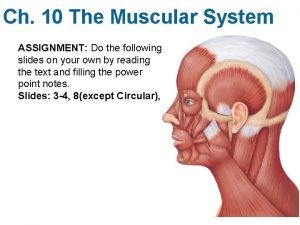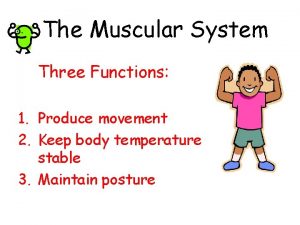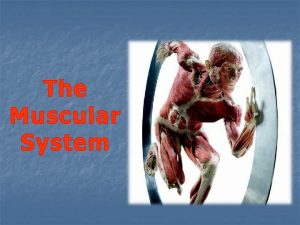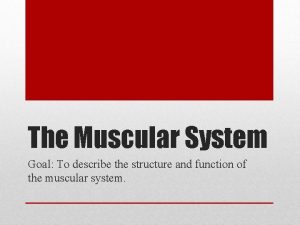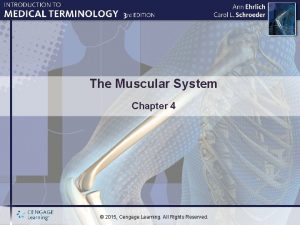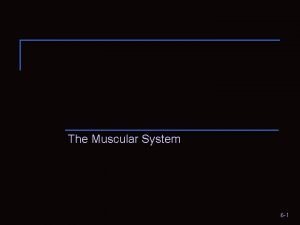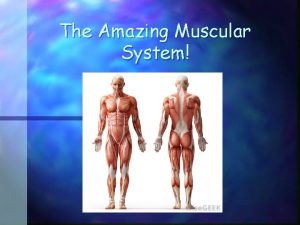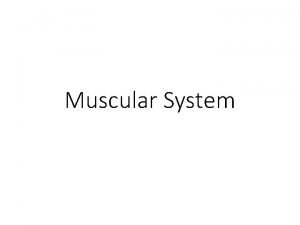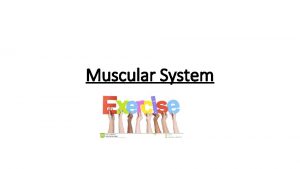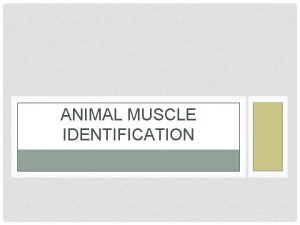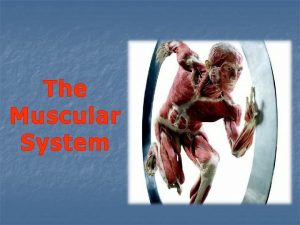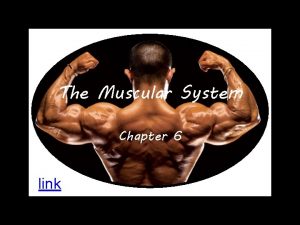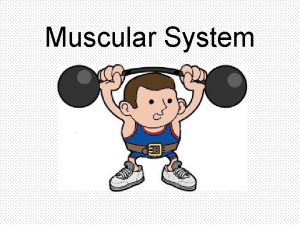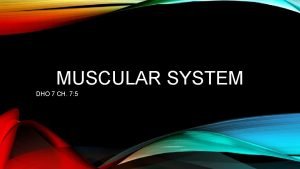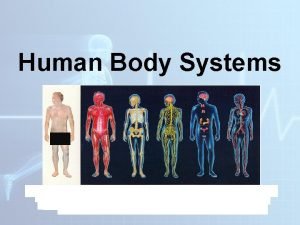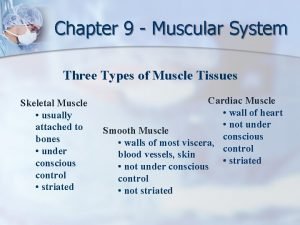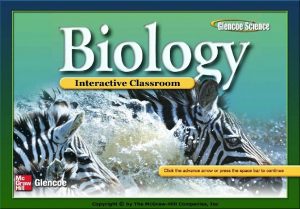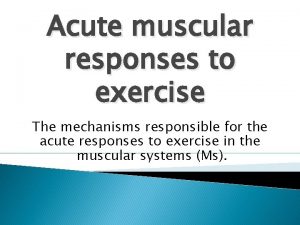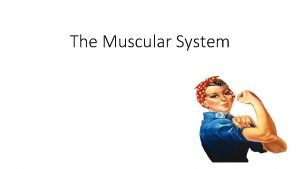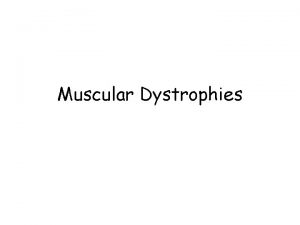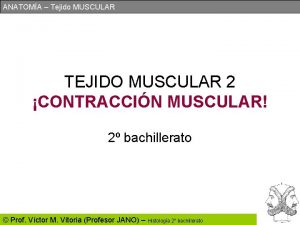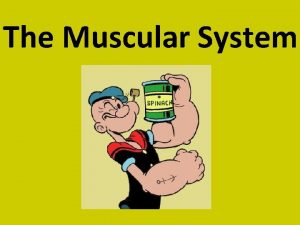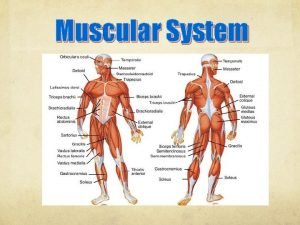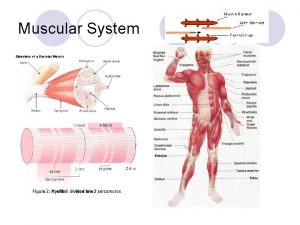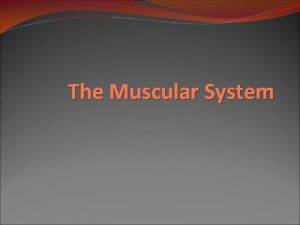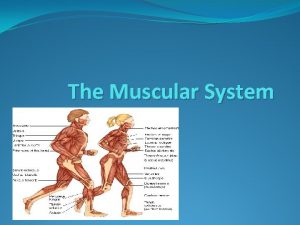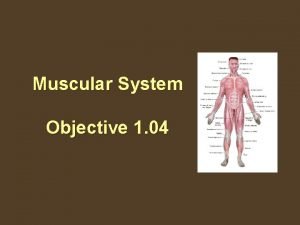Ch 10 The Muscular System ASSIGNMENT Do the






















- Slides: 22

Ch. 10 The Muscular System ASSIGNMENT: Do the following slides on your own by reading the text and filling the power point notes. Slides: 3 -4, 8(except Circular),

I. Introduction A. Types of Muscles by function 1. Agonist or Prime mover: • Predicting Actions: • Synergists: • Fixators: 2. Antagonist: - Example: Biceps & Triceps Brachii 3. Prime Movers and their Antagonist are on opposite sides of the Joint/Bones

B. Naming Skeletal Muscles 1. Direction of fibers § Rectus = straight 2. Relative size § Maximus = largest

3. By location § Temporalis 4. By number of origins § Triceps , Biceps

Naming Skeletal Muscles 5. By origin/insertion location § Sternocleidomastoid 6. By shape § Deltoid = triangular 7. By action § Flexor and extensor

C. Muscle Mechanics: Lever Systems 1. Components of a lever system in the Body a) Lever—rigid bar = insertion bone that moves on a fixed point or fulcrum = joint b) Effort—force = muscle contraction applied to a lever to move a resistance (load) c) Load—resistance = insertion bone + tissues + any added weight moved by the effort (c) Third-class lever Arrangement of the elements is load-effort-fulcrum Effort Load Fulcrum In the body: Flexing the forearm by the biceps brachii muscle exemplifies third-class leverage. The effort is exerted on the proximal radius of the forearm, the fulcrum is the elbow joint, and the load is the hand distal end of the forearm.

C. Muscle Mechanics: Lever Systems 2. Power versus Speed-- A lever allows a given muscle contraction to move a heavier body part OR to move a body part farther or faster a) Power Lever • Load (insertion bone and tissues) close to joint & muscle contraction farther from joint • Purpose: A small effort exerted over a large distance can move a large load over a small distance • Mechanical Advantage (b) Second-class lever Arrangement of the elements is fulcrum-load-effort Effort Load Fulcrum In the body: Second-class leverage is exerted when you stand on tip-toe. The effort is exerted by the calf muscles pulling upward on the heel; the joints of the ball of the foot are the fulcrum; and the weight of the body is the load.

C. Muscle Mechanics: Lever Systems 2. … a) Speed Lever • Load is far from the joint and muscle contraction force is closer to joint • Force of Contraction must be greater than the Load • Purpose: allow a load to be moved rapidly over a large distance • Mechanical Disadvantage (c) Third-class lever Arrangement of the elements is load-effort-fulcrum Effort Load Fulcrum In the body: Flexing the forearm by the biceps brachii muscle exemplifies third-class leverage. The effort is exerted on the proximal radius of the forearm, the fulcrum is the elbow joint, and the load is the hand distal end of the forearm.

What To Know for lab– MUSCLES • **Identify muscle • Muscles Groups (Quadriceps …) ** Really Important * Important • *Actions from lab book • Prime Mover, Synergistic, Antagonistic • *Origin & Insertion: from Lab Book and general location on bone– distal, middle proximal TIPS The Insertion and Origin indicate what the Actions are. You must know what side of the bones they are on and whether they attach on the proximal or distal parts of the bones; then it is easier to predict the Actions. The best way to learn Actions is to act out the movement while feeling for the muscle contracting and considering where the insertions and origins are.

II. Muscles that cause facial expressions and that move the head Epicranius Corrugator supercilii *Orbicularis oculi Levator labii superioris *Zygomaticus minor and major *Buccinator Risorius *Orbicularis oris Mentalis Depressor labii inferioris Depressor anguli oris Platysma Galea aponeurotica *Frontal belly (Frontalis) Occipital belly *Temporalis *Masseter *Sternocleidomastoid *Trapezius Splenius capitis Figure 10. 6

C. Arrangement of muscle fibers into Fascicles: 1. Circular: * Students Do Rest Figure 6. 14

Head and Neck Muscles- Muscle to do in Lab Figure 6. 15

A. MUSCLES OF MASTICATION AND TONGUE MOVEMENT Four pairs: 1. Prime movers of jaw closure Temporalis a) Temporalis and masseter § Cranial Nerve VII, Facial § Do in lab Masseter 2. Grinding movements b) Medial and lateral pterygoids Cranial nerve V (trigeminal nerve) See LAB BOOK for INSERTIONS, ORIGINS, and ACTIONS Medial & Lateral pterygoid muscles

Temporalis Orbicularis oris Buccinator Masseter (a) Figure 10. 7 a

Lateral pterygoid Medial pterygoid Masseter pulled away (b) Figure 10. 7 b

B. Facial Expression Muscles-- SEE LAB BOOK a) Epicarnius-Frontal Belly = Frontalis - Elevates eyebrows & wrinkles forehead b) Orbicularis muscles = muscle forms a ring around a part of the face i) Orbicularis Oculi: encircles eye - Closes eye ii) Orbicularis Oris: encircles lips/mouth - Brings lips together, kissing c) Zygomaticus (two parts) - Elevates sides of mouth, smiling d) Buccinator– mostly deep to iand below the mostinferior zygomaticus - Compresses checks inward-- wistling

C. Muscles of the Neck that move Head FLEXION a) Sternocleidomastoid— - If both sides contract together causes head flexion - If one side contracts only, causes lateral rotation b) Scalenes— - deep to Sternocleidomastoid - Cause lateral head rotation EXTENSION a) Trapezius: upper back muscle that extends to back of head - Extends head and other movements (will do later) © 2013 Pearson Education, Inc.

1 st cervical vertebra Sternocleidomastoid Base of occipital bone Mastoid process Middle scalene Anterior scalene Posterior scalene (a) Anterior Figure 10. 9 a

Figure 10. 9 b Muscles of the anterior neck and throat used in swallowing. Platysma (cut) Mylohyoid Omohyoid (superior belly) Sternohyoid Sternocleidomastoid END © 2013 Pearson Education, Inc.

END

Use for Practice Quiz

Effort x length of effort arm = load x length of load arm (force x distance) = (resistance x distance) Effort 10 kg 0. 25 cm Effort 25 cm Fulcrum 10 x 25 = 1000 x 0. 25 250 = 250 1000 kg Load Fulcrum (a) Mechanical advantage with a power lever Figure 10. 2 a
 Muscular system head and neck
Muscular system head and neck Differentiate muscular strength from muscular endurance
Differentiate muscular strength from muscular endurance Three functions of the muscular system
Three functions of the muscular system Primary functions of the muscular system
Primary functions of the muscular system Function of muscles
Function of muscles Chapter 4 the muscular system labeling exercises
Chapter 4 the muscular system labeling exercises Muscular system figure
Muscular system figure Amazing facts about the muscular system
Amazing facts about the muscular system Greek and latin roots jeopardy
Greek and latin roots jeopardy Muscular system label
Muscular system label The muscular system chapter 6
The muscular system chapter 6 Sheep muscular system
Sheep muscular system Navigating the body skeletal system #1
Navigating the body skeletal system #1 Muscular system primary function
Muscular system primary function Chapter 6 the muscular system figure 6-9
Chapter 6 the muscular system figure 6-9 Whats in the muscular system
Whats in the muscular system 7:5 muscular system
7:5 muscular system Aerobic respiration exercise
Aerobic respiration exercise Structures of the muscular system
Structures of the muscular system Sarcromeres
Sarcromeres Chapter 32 section 3 the muscular system
Chapter 32 section 3 the muscular system Muscular system response to exercise
Muscular system response to exercise Whats the muscular system
Whats the muscular system
